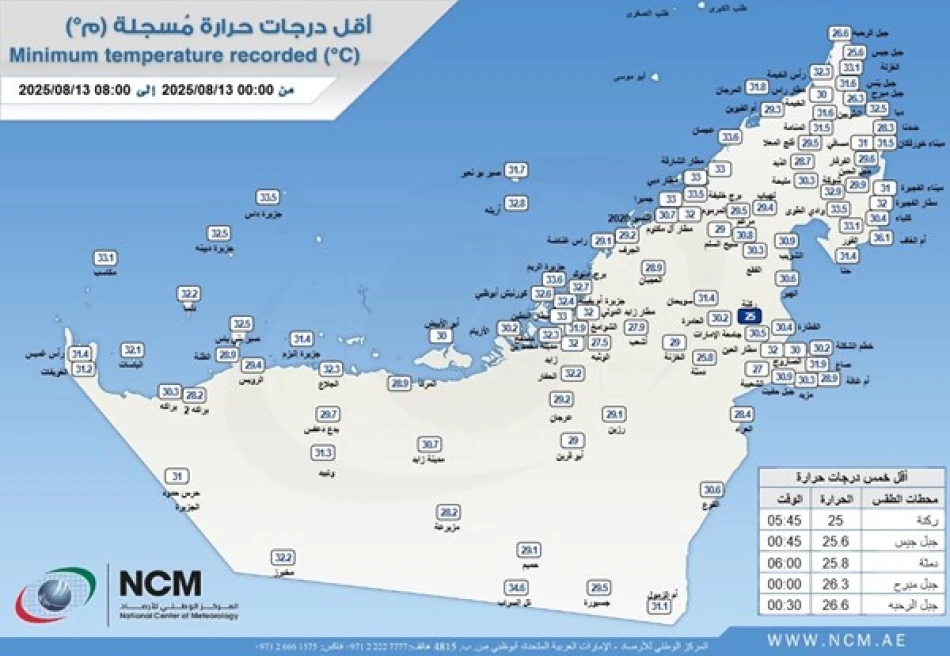
Ras Al Khaimah Records Coldest Temperature in the UAE
UAE Records Unusually High Winter Low of 25°C, Highlighting Climate Shift Concerns
The UAE's National Center of Meteorology recorded a minimum temperature of 25°C (77°F) on Wednesday morning, marking what would typically be considered a mild summer evening in most temperate regions as the country's coolest point of the day. The reading, taken at 5:45 AM local time in Rukna, Al Ain, underscores the Gulf nation's increasingly warm climate patterns and raises questions about long-term environmental sustainability in one of the world's most energy-intensive economies.
When "Cold" Means 77°F: UAE's Climate Reality
The temperature reading from Al Ain, traditionally one of the UAE's cooler inland areas due to its oasis location and slightly higher elevation, reflects the country's challenging climate dynamics. For context, this "minimum" temperature is warmer than typical summer highs in cities like London or San Francisco.
Al Ain's position as the coolest spot highlights the extreme nature of UAE's climate. The city, known as the "Garden City" for its relatively abundant greenery and natural springs, typically experiences the country's most moderate temperatures due to its inland location away from coastal humidity and its scattered oasis vegetation.
Economic Implications of Extreme Heat
Energy Consumption Surge
Such consistently high temperatures place enormous strain on the UAE's electrical grid, with air conditioning accounting for up to 70% of peak electricity demand during warmer months. The country's per-capita energy consumption ranks among the world's highest, driven largely by cooling needs in both residential and commercial sectors.
This energy intensity directly impacts the UAE's economic diversification efforts. While the nation benefits from abundant oil and gas resources to power its grid, the sustainability of such consumption patterns becomes increasingly questionable as global climate policies tighten and renewable energy transitions accelerate worldwide.
Tourism and Outdoor Economy Challenges
The UAE's ambitious tourism targets, including plans to attract 40 million visitors annually, face headwinds from extreme temperatures that limit outdoor activities and increase visitor discomfort. Dubai and Abu Dhabi have invested billions in indoor attractions and climate-controlled environments, but the fundamental challenge of year-round habitability without artificial cooling remains.
Regional Climate Trends and Comparisons
The UAE's temperature patterns align with broader Gulf region trends, where countries like Kuwait and Saudi Arabia regularly experience similar extreme heat. However, the consistency of high minimum temperatures sets the UAE apart from even its regional neighbors, largely due to urban heat island effects in rapidly developed cities like Dubai and Abu Dhabi.
Compared to other desert regions globally, the UAE's coastal humidity combined with desert heat creates particularly challenging conditions. Cities like Phoenix, Arizona, or Alice Springs, Australia, may reach similar peak temperatures but typically experience more significant nighttime cooling.
Infrastructure and Development Pressures
The persistent high temperatures force unique infrastructure considerations that add substantial costs to development projects. Building codes must account for extreme thermal stress, cooling systems require oversizing, and outdoor infrastructure faces accelerated degradation.
These factors contribute to higher construction and maintenance costs compared to more temperate climates, impacting everything from housing affordability to industrial facility planning. The UAE's push toward sustainable building practices and green construction standards partly responds to these climate-driven economic pressures.
Looking Ahead: Adaptation Strategies
The UAE's response to its extreme climate involves significant investment in renewable energy, particularly solar power, which paradoxically benefits from the same intense sunlight that drives cooling demands. The country's ambitious clean energy targets aim to generate 50% of power from renewable sources by 2050.
Additionally, urban planning initiatives focus on creating more walkable, shaded environments and expanding public transportation to reduce heat exposure. However, the fundamental challenge remains: maintaining economic growth and quality of life in an environment where outdoor temperatures rarely drop below what most of the world considers uncomfortably warm.
Most Viewed News

 Layla Al Mansoori
Layla Al Mansoori






